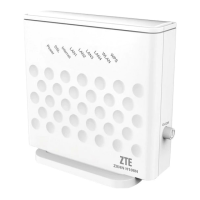ZTE H108N V.2.1 Configuration manual
Page 20 ZTE Proprietary and Confidential
Regarding the “protocols” available:
Bridging: the device will become a simple switch/bridge with five ports (4
ETH + 1 DSL), and the traffic is repeated as-is to any port.
Your PC(s) will need to have public address/es, and also require an
external remote gateway. Your network will be public and externally
routable.
Most internet providers (but not all) can support this kind of traffic on their
network (DSLAMs), or even allow you to have more than one public IP
address.
All routing functions of the H108N are turned off just for this “pure
bridging mode”, so NAT is not possible here.
If your internet provider requires a PPPoE session, but you want to
configure the router in “bridging mode”, you will need to establish the
connection from your PC(s) manually.
MER (MAC Encapsulated Routing): equivalent to the above, the device will
also bridge the traffic “MAC packets” to the DSL port, but it will encapsulate it
first for the VC. For this reason it often has other equivalent names:
“Ethernet encapsulation” or “IPoEoATM”
“RFC1483 or RFC2684”
“RFC1483 or RFC2684 bridged” (no “IP” here)
IPoA (IP over ATM): the device will route the traffic (IP packets), and
encapsulate it for sending over your DSL line (ATM). For this reason it has
other equivalent names:
“RFC1483 or RFC2684 bridged IP”
“RFC1483 or RFC2684 routed”
For the two latter protocols, the RFC2684 allows your router to perform
bridging on the WAN side while routing on the LAN side (thus NAT).
Finally, the PPPoE and PPPoA match the two latter protocols, but the router
will establish a PPP session to deliver the traffic to the right gateway.

